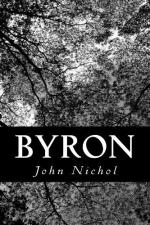River that rollest by the ancient walls
Where dwells the lady of my
love.
[Footnote 2: In December, 1820, Byron sent several more sheets of memoranda from Ravenna, and in the following year suggested an arrangement by which Murray paid over to Moore, who was then in difficulties, 2000_l_. for the right of publishing the whole, under the condition, among others, that Lady Byron should see them, and have the right of reply to anything that might seem to her objectionable. She on her part declined to have anything to do with them. When the Memoirs were destroyed, Moore paid back the 2000_l_., but obtained four thousand guineas for editing the Life and Correspondence.]
Again passing through Ferrara, and visiting Bologna, he left the latter on the 8th, and on his arrival at his destination found the Countess dangerously ill; but his presence, and the attentions of the famous Venetian doctor, Aglietti, who was sent for by his advice, restored her. The Count seems to have been proud of his guest. “I can’t make him out at all,” Byron writes; “he visits me frequently, and takes me out (like Whittington the Lord Mayor) in a coach and six horses. The fact appears to be, that he is completely governed by her—and, for that matter, so am I.” Later he speaks of having got his horses from Venice, and riding or driving daily in the scenery reproduced in the third canto of Don Juan:—
Sweet hour of twilight! in the solitude
Of the pine forest, and the
silent shore
Which bounds Ravenna’s immemorial
wood.
On Theresa’s recovery, in dread of a possible separation he proposed to fly with her to America, to the Alps, to “some unsuspected isle in the far seas;” and she suggested the idea of feigning death, like Juliet, and rising from the tomb. Neither expedient was called for. When the Count went to Bologna, in August, with his wife, Lord Byron was allowed to follow; and—after consoling himself during an excursion which the married pair made to their estate, by hovering about her empty rooms and writing in her books—he established himself, on the Count’s return to his headquarters, with her and Allegra at Bologna. Meanwhile, Byron had written The Prophecy of Dante, and in August the prose letter, To the Editor of the British Review, on the charge of bribery in Don Juan. Than this inimitable epistle no more laughter-compelling composition exists. About the same time, we hear of his leaving the theatre in a convulsion of tears, occasioned by the representation of Alfieri’s Mirra.




